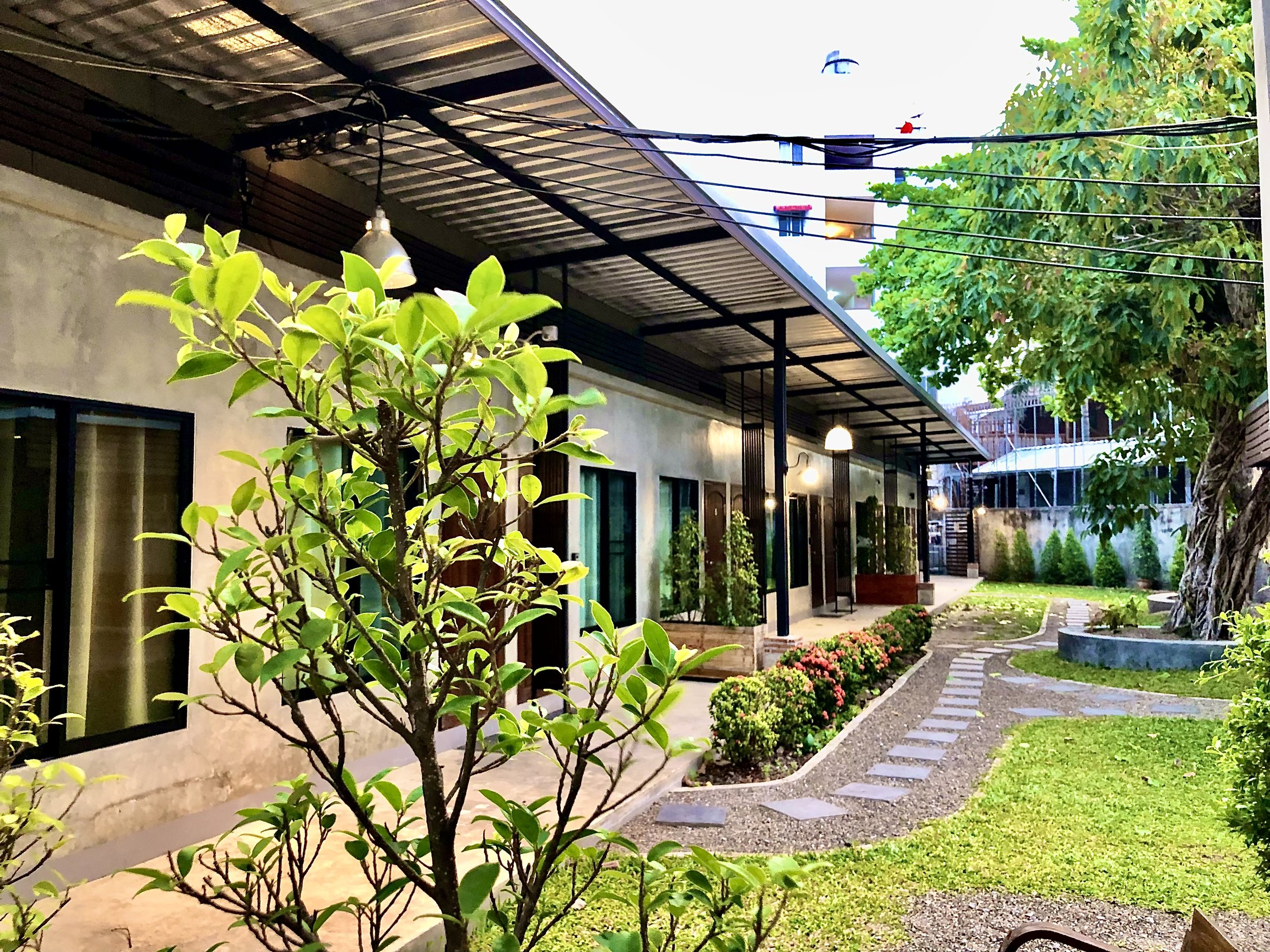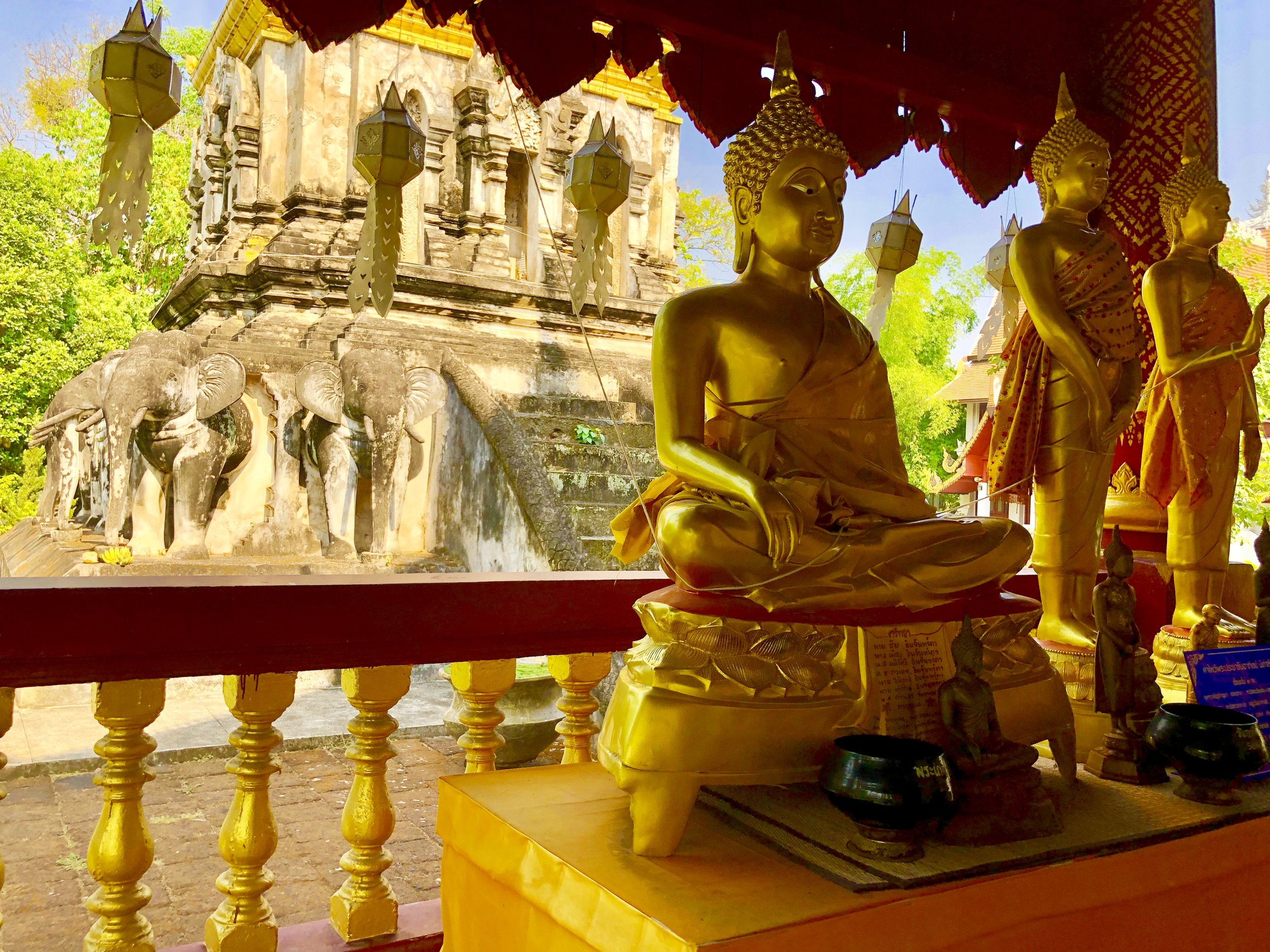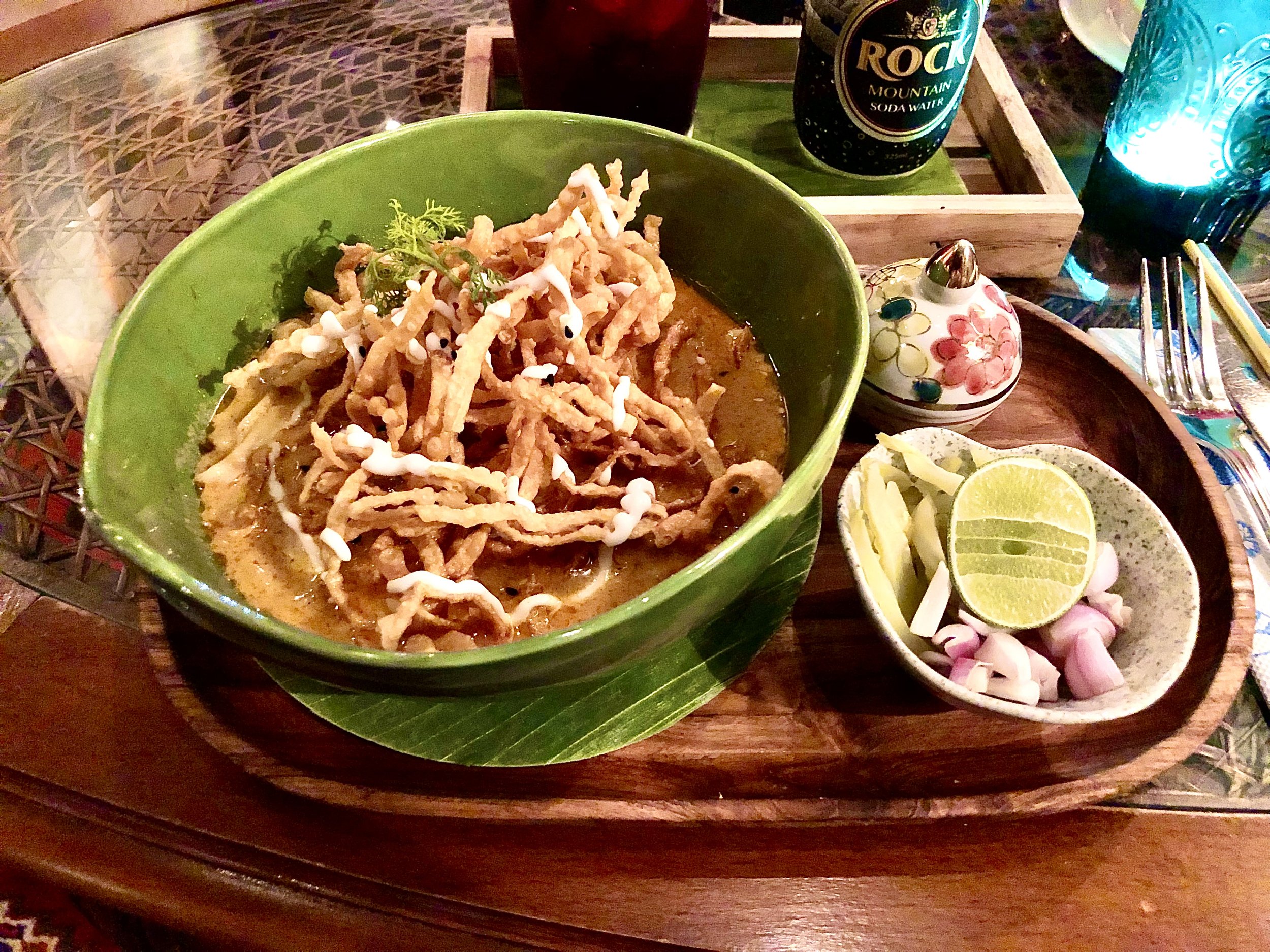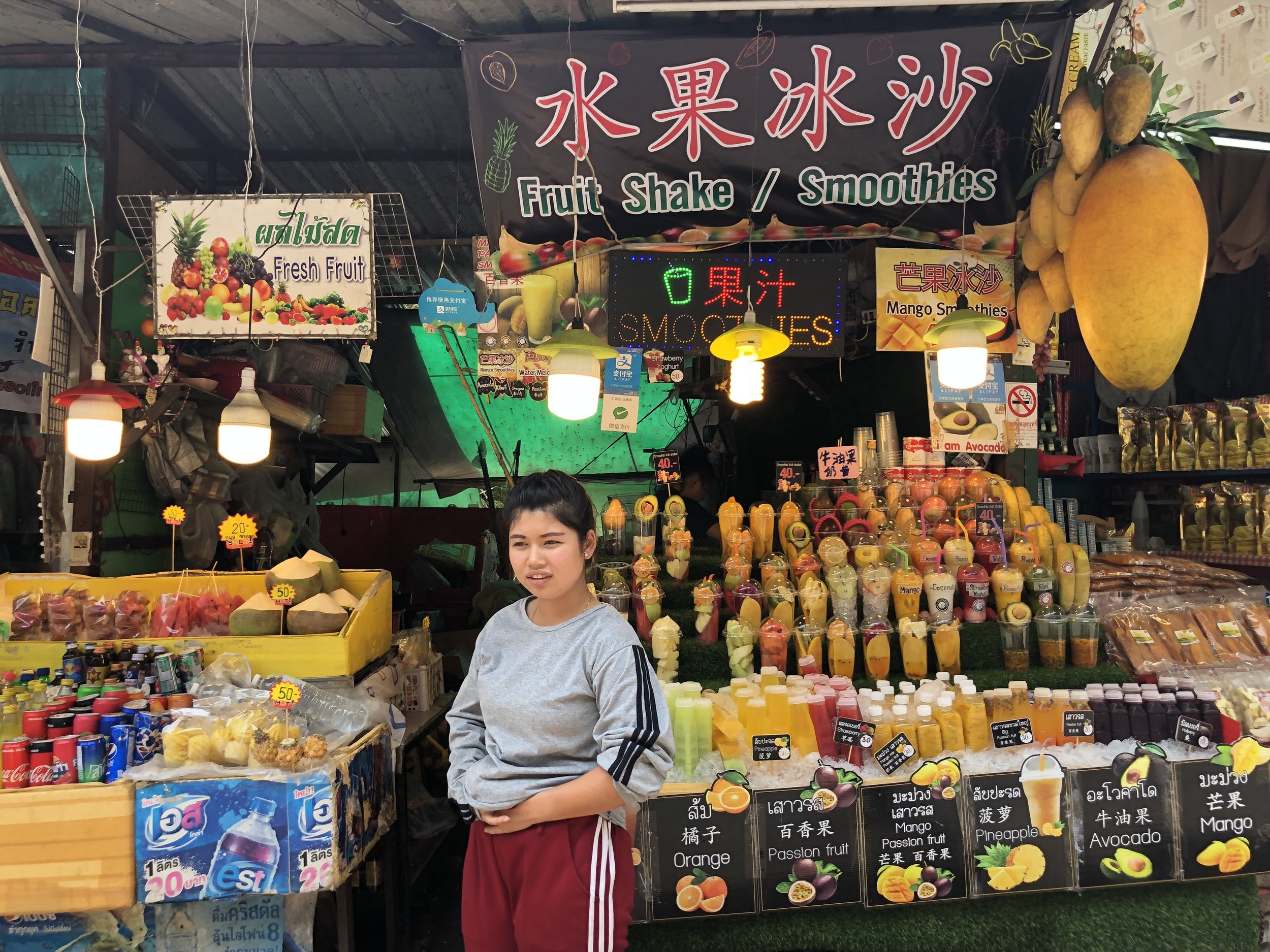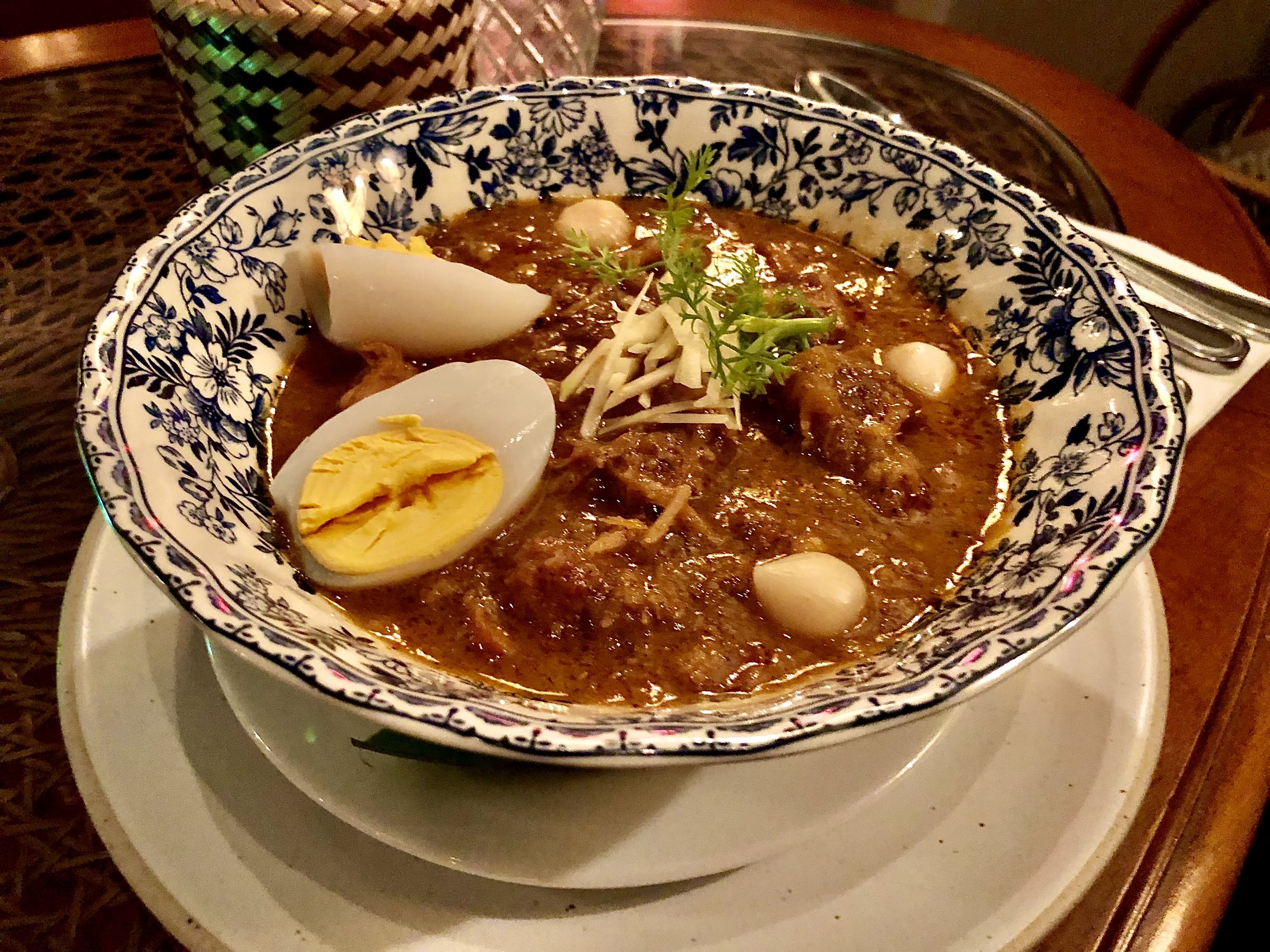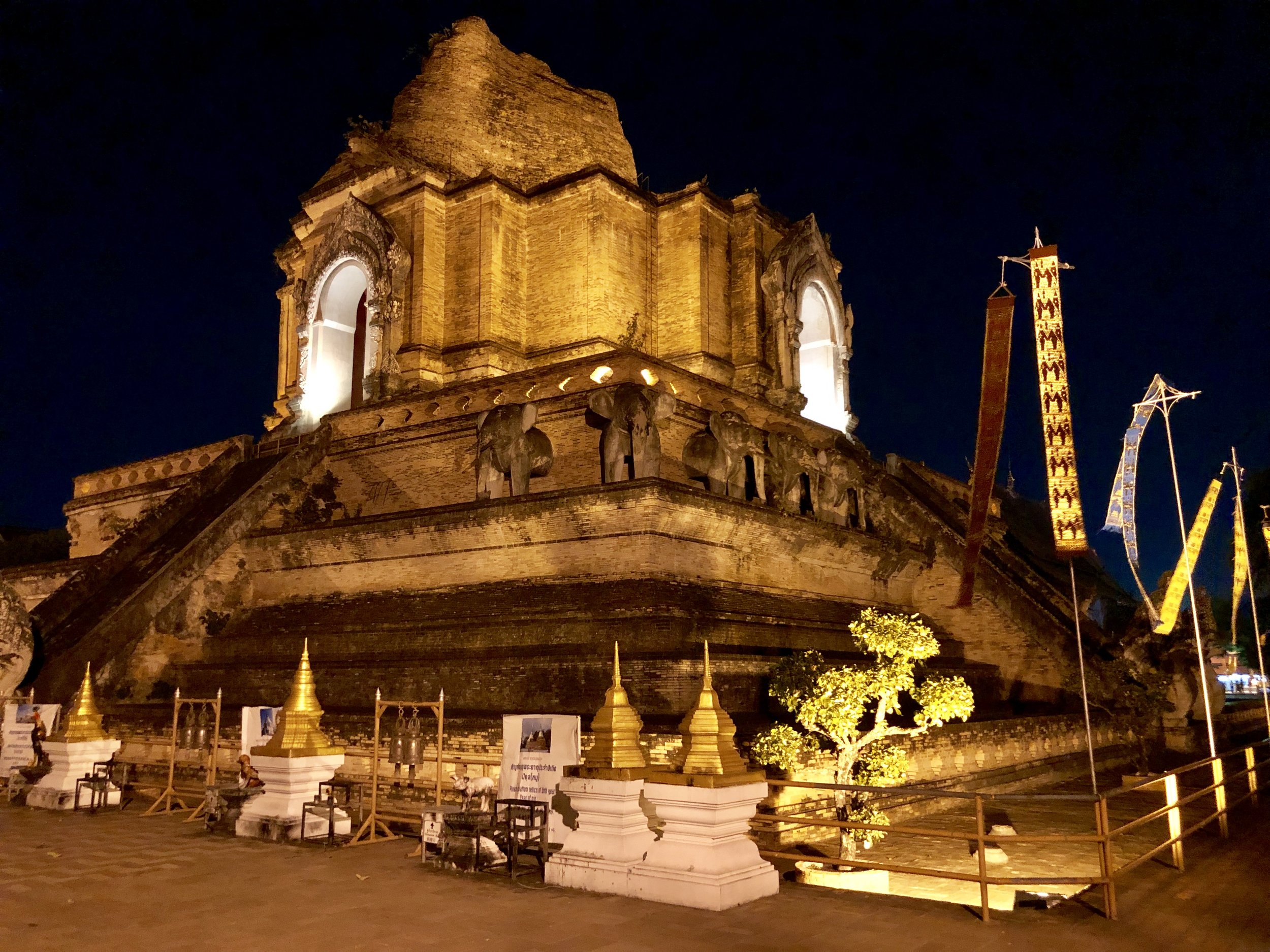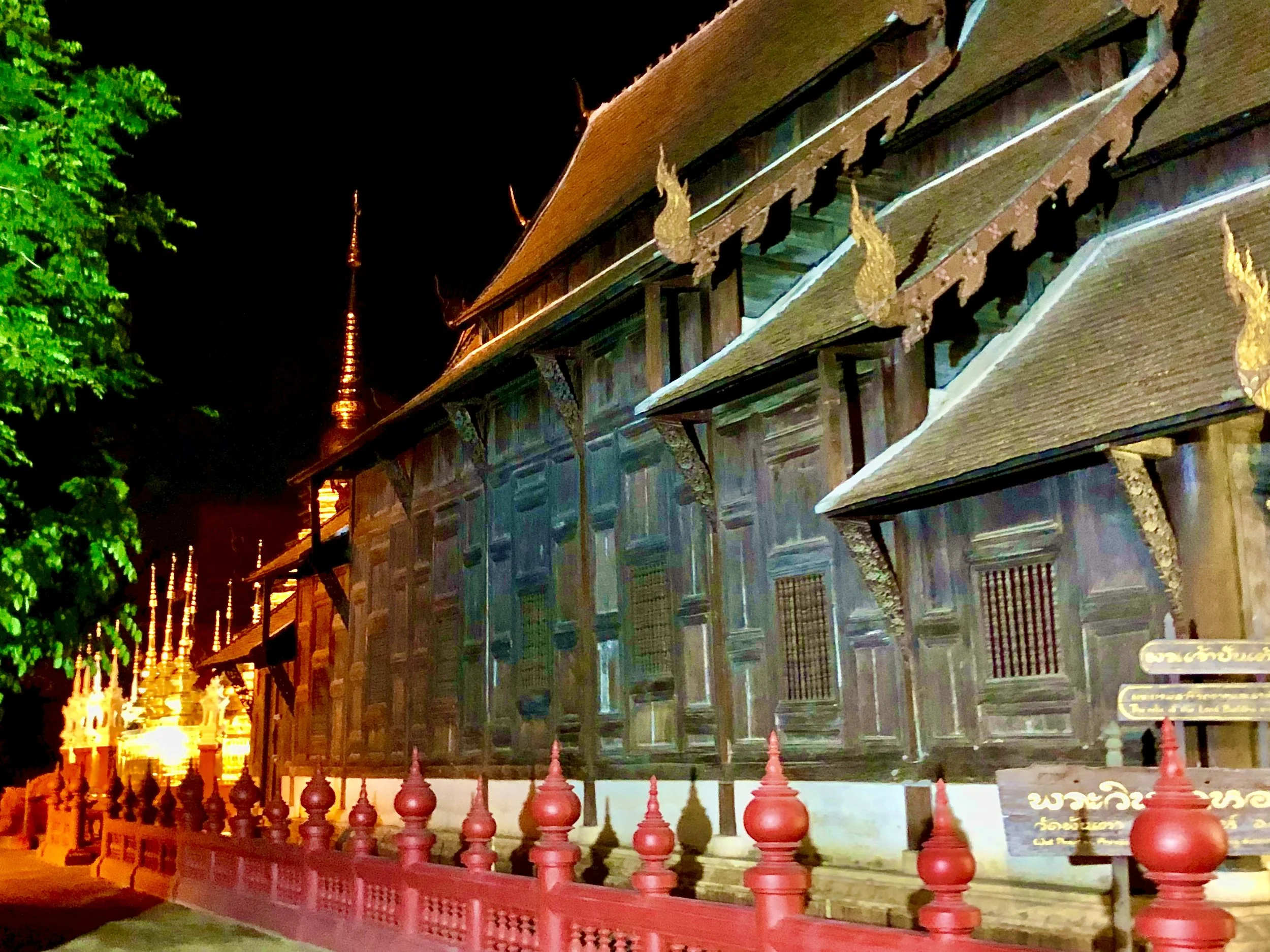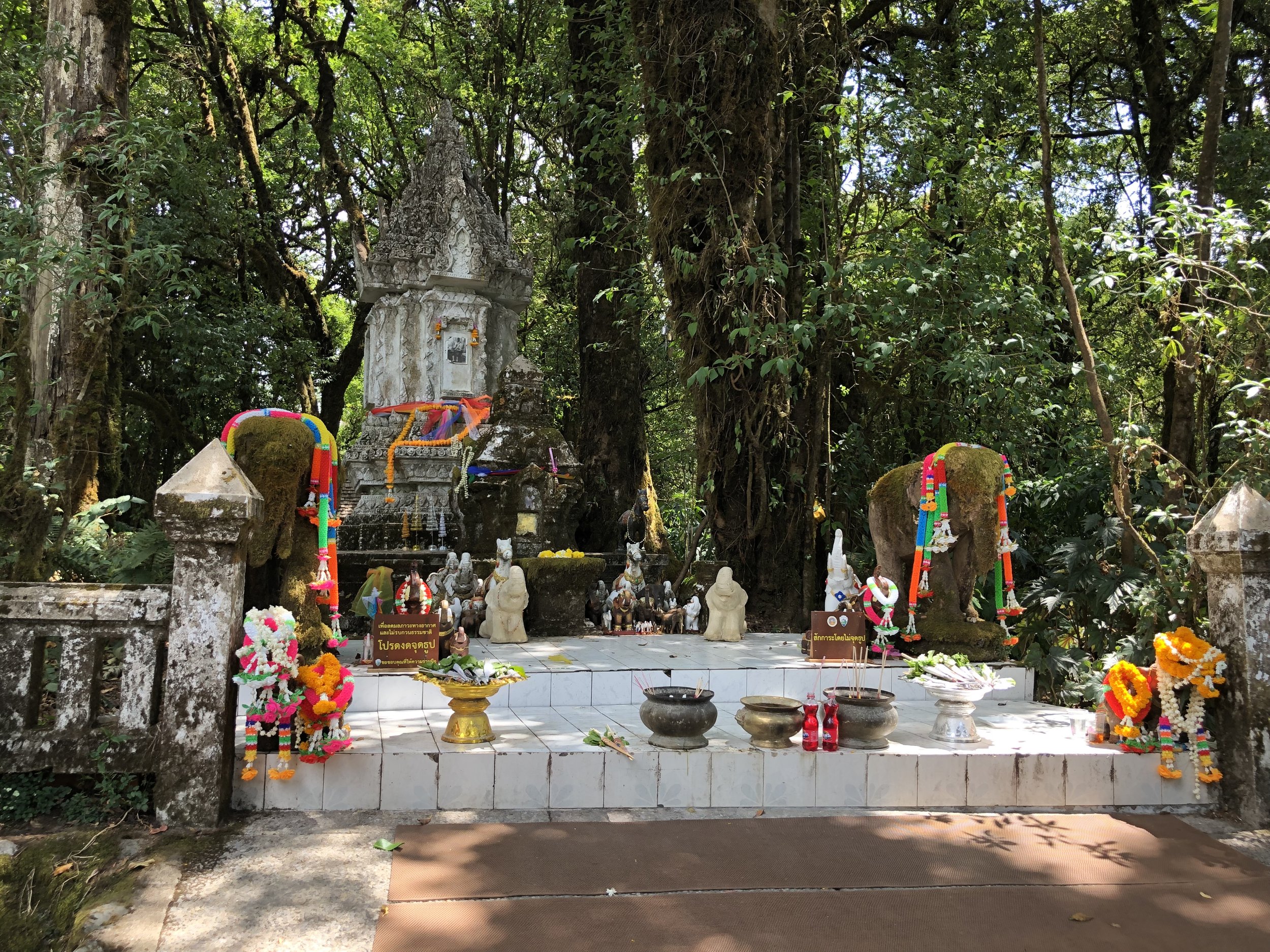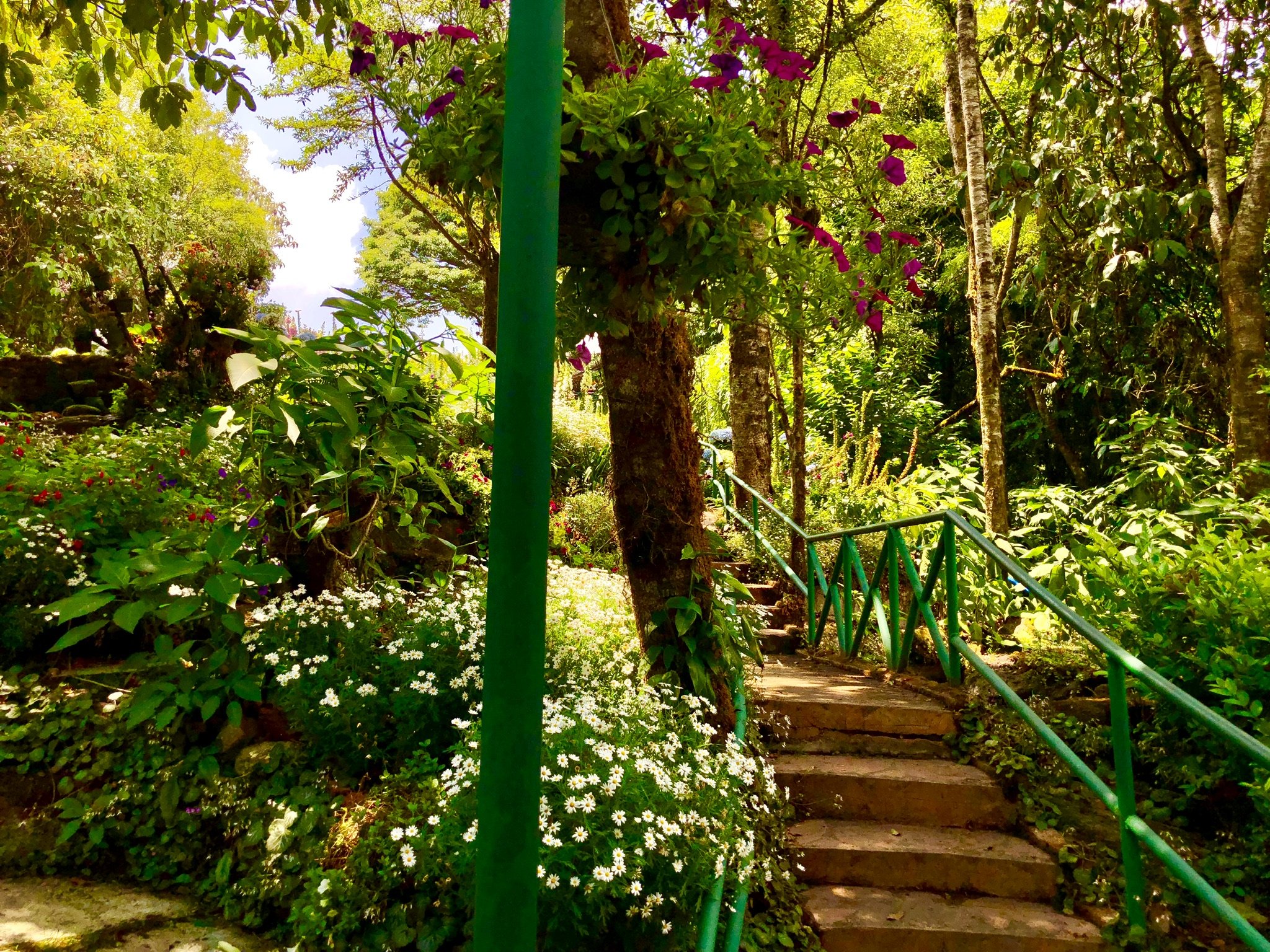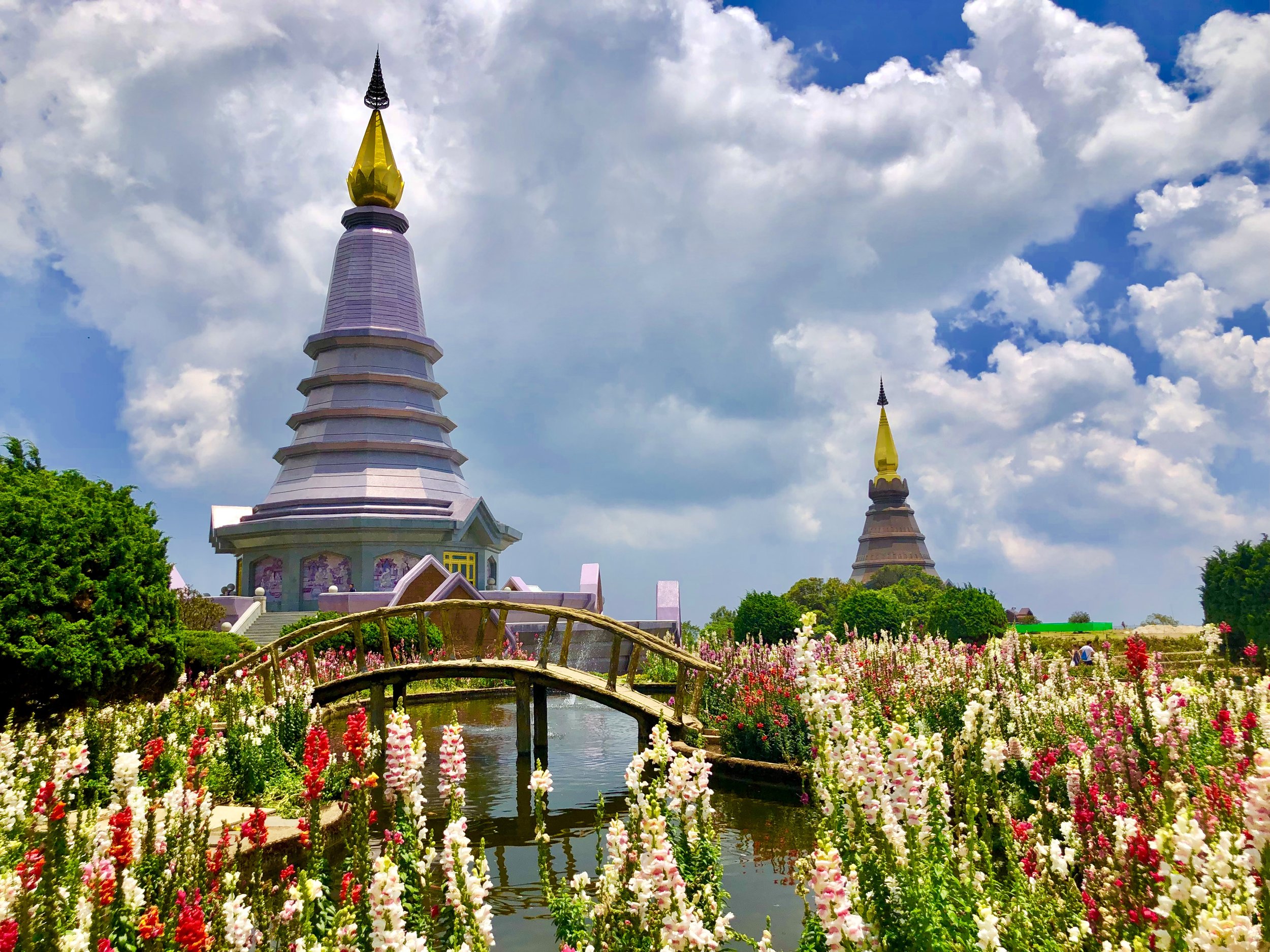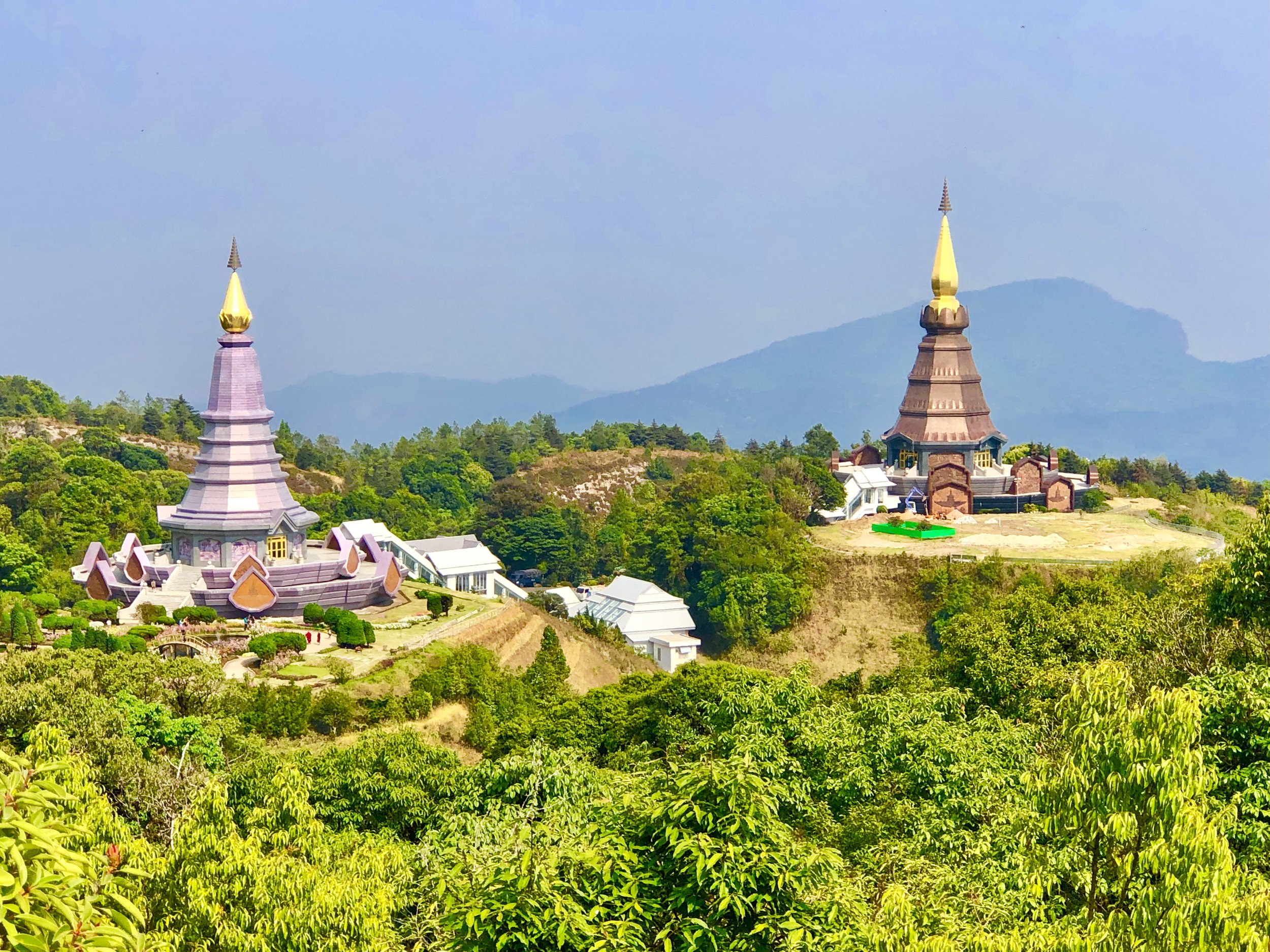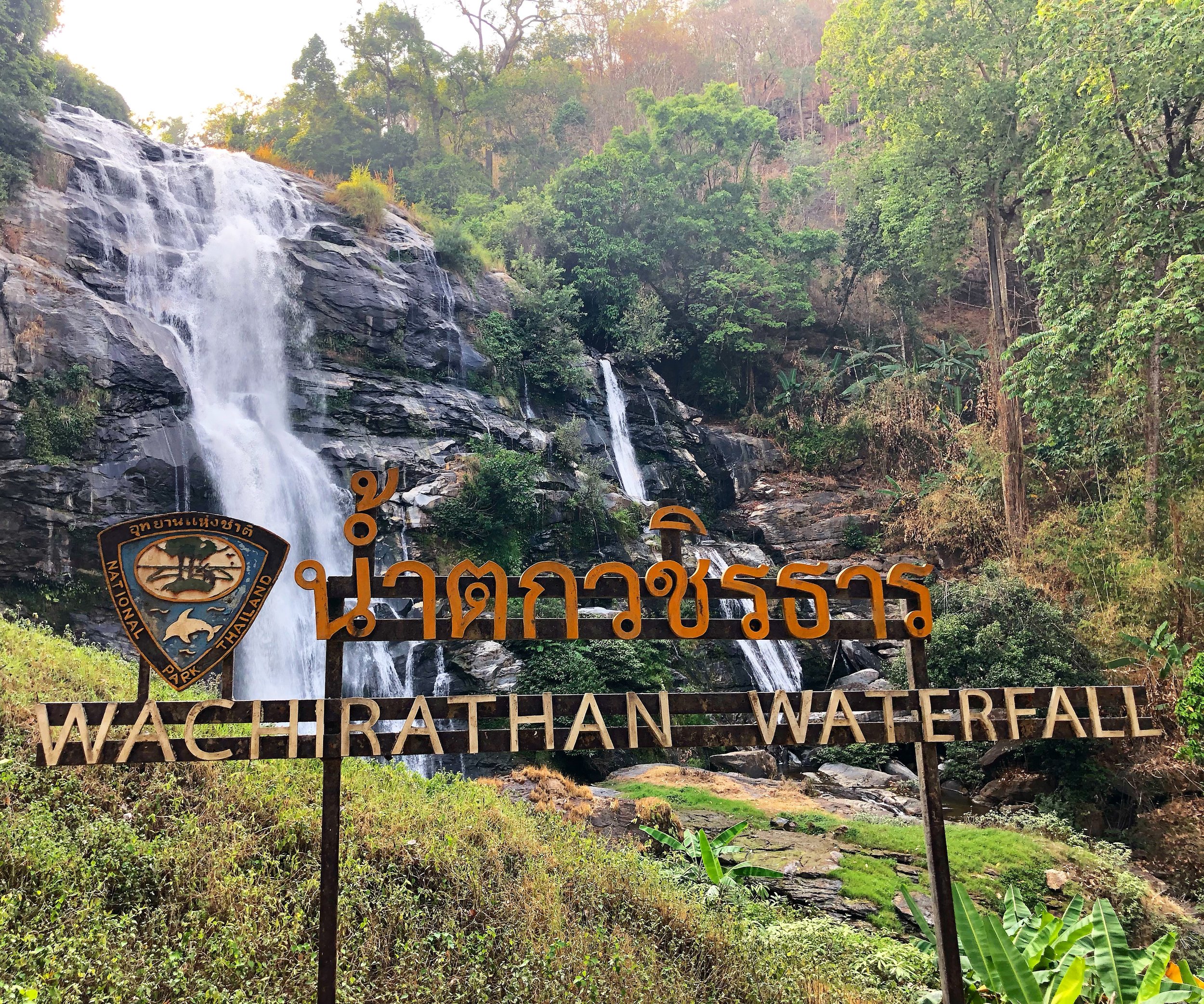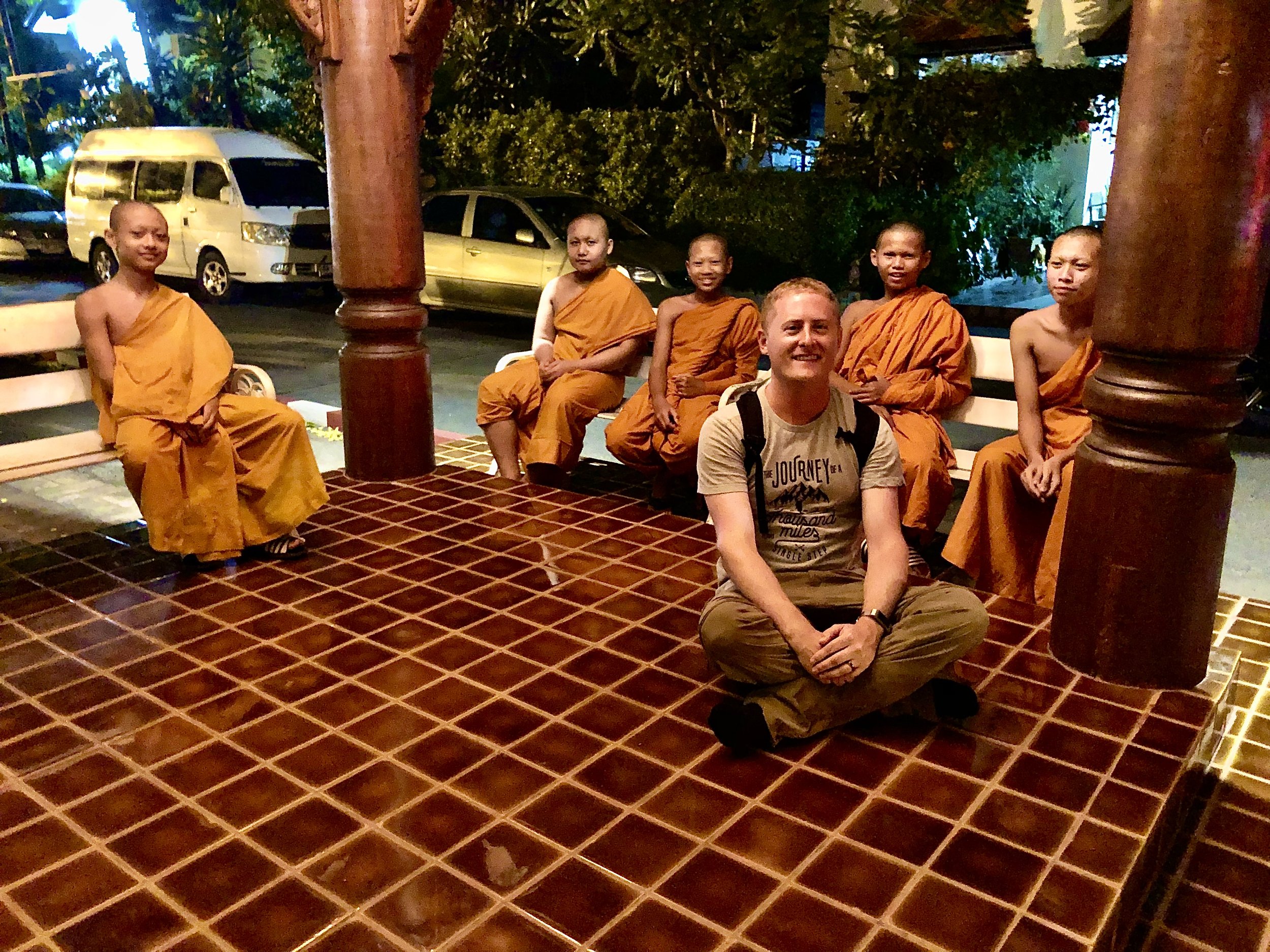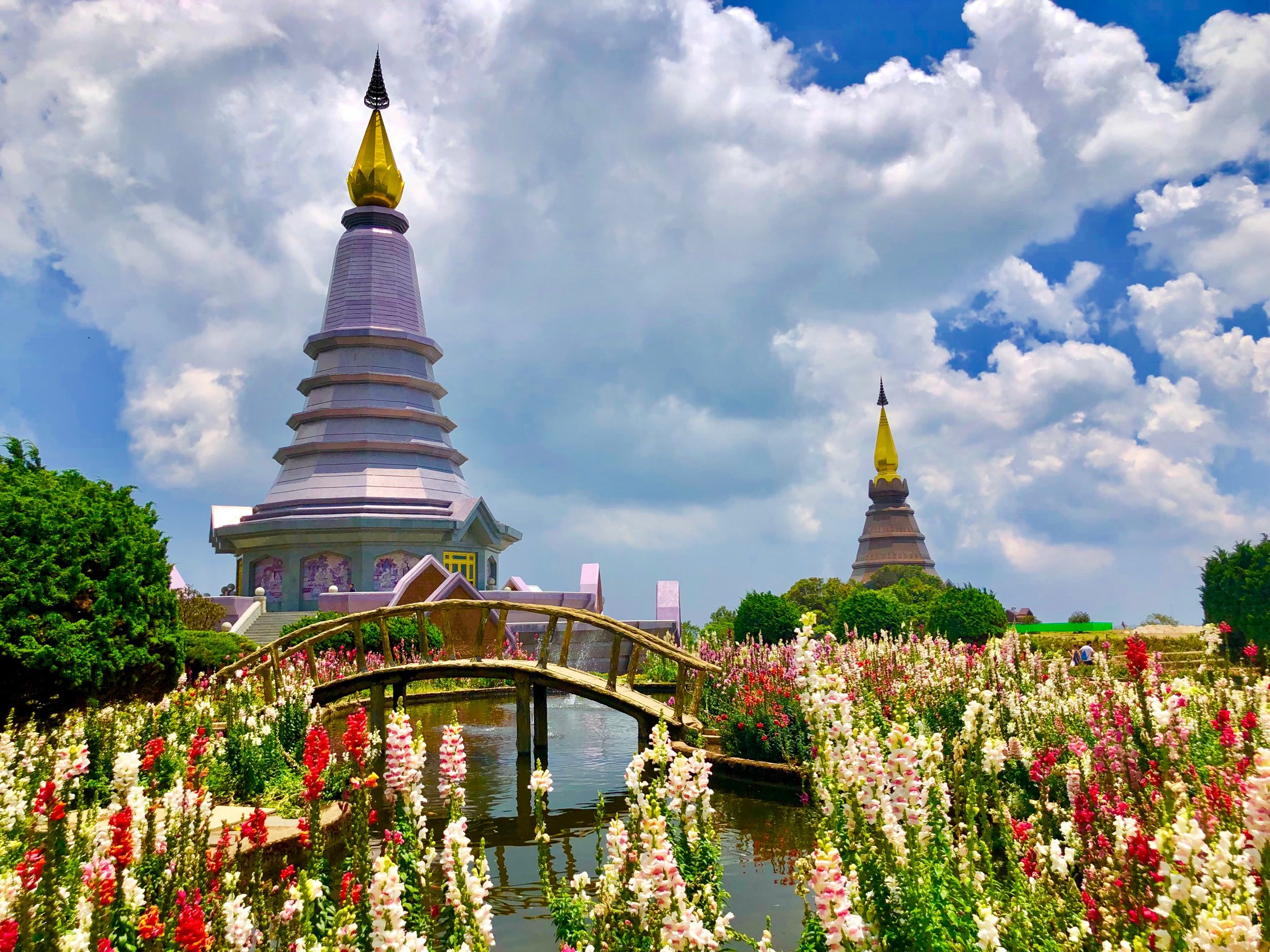Best things to do in Chiang Mai - An Ancient City Full of Legends and History
Wat Phra That Doi Suthep jade Buddha
Destinations > Asia > Thailand > Best things to do in Chiang Mai - An Ancient City Full of Legends and History
Ancient City of Legends and History
The best things to do in Chiang Mai, the Capitol city of the ancient Lanna Kingdom, founded in the late 13th century by its first ruler, King Mangrai. A small city that has blossomed but still brimming with ancient 14th and 15th century temples and historic structures.
We arrived in Chiang Mai, which sits on the banks of the Ping River in Northern Thailand, as a quick retreat from our stay in Bangkok. This occurred at the very beginning of our second year of traveling the world full time, and our first year of being parents - our son born only two months earlier in Cape Town, South Africa. It was a fun first adventure for him, and a great retreat from the busy city, although some parts cater more towards single people than to families!
This article covers the best things to do in Chiang Mai including the best places to eat, wander, and explore in Chiang Mai, Thailand.
Learn more about this country, and its customs and culture, by reading the short Culture Smart! book today!
Thailand is right-side driving
Car Rental in Chiang Mai - Airport
Do you need a car when visiting the best things to do in Chiang Mai? Chiang Mai is the largest city in Northern Thailand, but it is still rather small. There’s plenty to do and see in the city center, so you will likely spend most of your time exploring that area. Walking, or using the city’s iconic Songthaew, may be perfectly fine to get around. Also, when we took a tour out to the Kanta Elephant Sanctuary, we didn’t need a car as it included transportation to and from the sanctuary.
However, to see some of the more iconic areas outside of the city, you’ll need a car. It's easiest to just rent a car at the Chiang Mai airport, like we did, to get to the Doi (mountains). If you have a baby (especially under 2 years old), we recommend you bringing your own car seat. The rental companies sometimes offer car seats for an additional fee, but in our experience they did not have rear-facing or suitable for children under 2 or 3 years old.
Where to stay in Chiang Mai
East Moat courtyard area
East Moat
We stayed at the East Moat Chiang Mai, an affordable guesthouse located just a short distance east of the city center. At first glance the guesthouse has a rather simple facade, but its comfy interior combines Thai culture with a touch of modern decor. Each room features exposed cement walls, furniture made out of natural woods, and a couple of rattan lamps lighting the space.
There is an outdoor lounge and courtyard that you can use for some fresh air as well as a locker area where you can secure some belongings while you're exploring Chiang Mai.
While it's a decent place for a low budget, we have a few different places/areas that we recommend to our Nomad Pass members, especially if they are families.
Best things to do in Chiang Mai
Wat Chiang Man with golden Buddha and 'Elephant Chedi'
Best Things to do in Chiang Mai: Wat Chiang Man
What’s a trip to Chiang Mai without setting foot at its oldest temple? Wat Chiang Man temple was built in 1296 by the founder of the city, King Mangrai - which explains why most parts of the temple are influenced by the Lanna-style architecture. He used the temple to supervise the construction of the city.
Inside the temple complex, you will find several unique structures including the famous “Elephant Chedi” - a relic chamber with a square base surrounded by 15 carved elephants. The complex also houses two meditation halls that are heavily adorned in glimmering gold and red, as well as a few old images of Buddha.
Just a few steps from the entrance are two Buddha statues. One is worshipped by the devotees before Songkran and is believed to have rain-giving powers while the other one is made out of clear quartz crystal and is said to have healing abilities.
Wat Chiang Man is open from 5 am to 9 pm.
Bathing elephants at the Kanta Elephant Sanctuary
Best Things to do in Chiang Mai: Kanta Elephant Sanctuary
Elephants are considered sacred for Buddhists as they symbolize wisdom, strength, and luck. They are also the official national animal of Thailand. Unfortunately, elephants have not historically been treated well in captivity. As tourism shifts to become more ethical, sanctuaries have become havens for elephants that were previously used for unethical tourism attractions or forced to work in the logging industry.
At Kanta Elephant Sanctuary, you will get a chance to take a closer look at these animals, socialize with them, feed them, and get in the freshwater lagoons and bathe them! While spending some quality time with the friendly elephants and watching them roam freely around the area, you’ll also get to learn all about elephants and their behaviors.
The price to enter Kanta Elephant Sanctuary differs depending on what package you choose. Half-day visits cost around 1,500 Baht while a full-day visit costs 2,500 Baht, per person. So, be sure to check out their website!
We also wrote a specific article about our experience there with more information.
Our favorite dish in Chiang Mai, Thailand, is Khao Soi
Best Things to do in Chiang Mai: Khao Soi
While you’re in the city, be sure to get a taste of Chiang Mai’s local flavor. Khao Soi is a dish originating from Chiang Mai itself.
This dish consists of crispy noodles, half a hard boiled egg, and some type of meat or tofu soaked in a bowl of thick, and usually slightly spicy, coconut broth.
A little backstory behind the dish - it was introduced by the Chinese-Muslims back in the late 19th-century when they first migrated to the city.
You can find some of the best Chiang Mai Khao Soi at “Khao Soi Khun Yai” and “Khao Soi Wulai”. These two eateries are the most popular ones in the city and the price of the dishes are very reasonable!
Wat Phra That Doi Suthep golden temple area
Best Things to do in Chiang Mai: Wat Phra That Doi Suthep
Wat Phra That Doi Suthep, commonly known as Doi Suthep Temple, is a sacred site perched on a mountainside 1,073 meters above sea level. One of the many things that makes this place special the legend that a white elephant climbed the hill, carrying a bone, trumpeted three times, and then suddenly died.
It is believed that the piece of bone belonged to Gautama Buddha himself! Looked at as an omen, a temple was built in 1383. Today, this temple is glimmering with gold and has a number of beautiful spots to take photos. It is regularly frequented by Buddhist monks as well as tourists. We loved our time at Doi Suthep temple and would recommend to anyone visiting Chiang Mai to stop and see how magical it is here.
To visit Wat Phra That Doi Suthep, first drive most of the way up the hill to Sriwichai Alley - an area with many street stalls - where you'll likely need to park along the side of the road. Don’t pass it up like we did, as the road continues up the hill but isn't meant for through traffic.
Along the side of the road is a large set of stairs that you'll need to climb to reach the lower food stands and souvenir shops of Doi Suthep. You’ll notice a pair of ornate serpents in this area guarding a 309 step staircase that leads to the temple complex.
Take your time exploring the temple grounds as it boasts a great number of structures ranging from the gold-plated chedi - which is the holiest area of the temple - to pagodas, bells, shrines, and a museum. Don't miss the statue of the legendary white elephant that carried the bone relic up the mountain. We also recommend wearing footwear that is easy to slip on and off as some areas of the temple require removing your shoes.
Wat Phrathat Doi Suthep opening hours: 6 am - 8 pm.
Sriwichai Alley at Wat Phra That Doi Suthep
Best Things to do in Chiang Mai: Sriwichai Alley
Sriwichai Alley is the main road located right in front of Wat Phra That Doi Suthep.
It’s pretty easy to spot as it is located along the road and this is the only area where you can park your car if you’re visiting the temple.
Right before you reach a set of stairs that’ll lead you to the temple, you’ll notice an array of shops and street vendors selling different kinds of food and local crafts. It’s a great spot to simply wander around and try a few bites of the local street food that's available there - from grilled corn on the cob and barbecued chicken to waffles and fresh fruit smoothies.
Support the local community by picking up a few handmade keychains, fridge magnets, or even a pair of iconic elephant pants - made famous in the movie “The Beach” starring Leonardo DiCaprio - as souvenirs or gifts for friends back home.
Please accept the prices that they request - do not try to negotiate - as the locals work hard to make a living and it's best to allow them some opportunity to make progress!
We ordered Kaeng Hang Lay and Khao Soi Gai, both great options!
Best Things to do in Chiang Mai: Ginger & Kafe
Ginger & Kafe Chiang Mai is a combination of a restaurant and a bistro. It has a modern and sleek look from the outside, but the interior stays true to Thai culture. Whether you’re planning for a romantic candlelight dinner or just a simple dinner with friends, Ginger & Kafe caters towards a more relaxed clientele.
We felt like we were sitting on couches in a lounge room in front of a fireplace, even though it was more of a culturally decorated and wallpapered, high ceiling room with old-fashioned tables, dishes, and couch-like chairs, all in a low candlelit setting - which made it incredibly cozy!
Ginger & Kafe’s food was calming and delicious as well. Their chef serves tantalizing Thai cuisines with unique twists. They combine traditional cooking techniques with organic ingredients from their own farm to enhance the flavors. You'll find a variety of tasty foods here, from crispy prawn spring rolls and deep-fried sea bass to steamed curry and Khao Soi. No wonder the restaurant managed to get included in the Michelin Guide!
Wat Chedi Luang at night
Best Things to do in Chiang Mai: Wat Chedi Luang
While looking for Wat Phan Tao to take a photo of its night-lights, we ended up at Wat Chedi Luang instead. It was initially constructed in the 14th century by King Saen Muang Ma to bury his father’s ashes.
The temple was partly destroyed due to an earthquake back in 1545, but - thanks to UNESCO and the Japanese government - Wat Chedi Luang temple was restored in the late 90s.
Among the prominent structures standing in the complex are the massive water serpent, the City Pillar - or “Lak Mueang” - of Chiang Mai, as well as the three giant gum trees. Legend has it that if one of the trees collapses to the ground, catastrophe shall fall upon our world.
To gain access to view the Wat and the grounds you'll need to pay a small entrance fee of about 40 Baht for adults and 20 Baht for children. Wat Chedi Luang is open from 8 am - 5 pm.
The wooden temple at Wat Phan Tao
Best Things to do in Chiang Mai: Wat Phan Tao
Located directly next to Wat Chedi Luang is Wat Phan Tao, a wooden temple surrounded by a lively garden. Unlike the other temples that are heavily decorated with gold platings and intricate stone carvings, this temple is more subtle, yet still quite pleasing to the eyes.
Also founded in the 14th century, Wat Phan Tao features an exquisite prayer hall that is made out of dark teakwood, which was actually a throne hall for King Mahotara Prateth. Today, you can find an image of the sacred Phan Tao Buddha enshrined here.
They also occasionally light up their garden area at night time, which makes for some fairly incredible night photos!
Path to the Highest Point in Thailand with offerings
Best Things to do in Chiang Mai: The Highest Point in Thailand
The highest peak in Thailand, Doi Inthanon, can be reached about two hours away from the city. We rented a car to travel out there, as parking areas are available at the waterfalls and pagodas. But you can book a guided tour instead if you don’t want to drive yourself. The mountain is mostly known for its nature park and the amazing view that it offers at its peak.
Standing with an elevation of 2,565 meters, the mountain got its name from Chiang Mai’s last King, Inthawichayanon, whose passion project was to preserve the city’s thick forest. After his death, his remains were brought to the mountain to be interred among mother nature.
Doi Inthanon National Park
Best Things to do in Chiang Mai: Doi Inthanon National Park
Being a part of the Himalayan mountain range, the national park has been attracting tourists from all over the world with its nature trails, quaint villages, and waterfalls. If you wish to include the Doi Inthanon National Park tour in your itinerary, be sure to rent a car or a bike beforehand as the area is massive.
With the cold and humid temperature, it’s advisable to bring a jacket. You can go on the many trails, admire the views and you might even spot a few unique bird species in their natural habitat!
A small fee of 300 Baht is needed to gain entry to this park and you also need to prepare an additional 30 Baht if you’re traveling by car and 20 Baht for bikes. Do keep in mind that Doi Inthanon National park is closed for tourists from 1st May to 30th July every year.
Doi Inthanon National Park opening hours: 5.30 am to 6.30 pm.
The Royal Pagodas and the Gardens at Doi Inthanon
Best Things to do in Chiang Mai: Royal Pagodas and the Gardens
Just five minutes down the mountain, you can easily spot a pair of striking pagodas standing in the middle of a beautifully kept garden complete with a mini bridge spanning across the pond. Dedicated to King Rama 9 and the Queen of Thailand, the Royal Pagodas have a slightly modern look - that’s because these structures were built in the late 20th century.
The King Pagoda sports a dark exterior with a height of 197 feet. Inside, you can find a statue of Buddha sitting in a teaching position and three different levels that symbolize the main principles of Buddhism. As for the lavender Queen Pagoda, the height is slightly shorter to signify the queen’s younger than the king age. Aside from the Buddha statue standing inside the pagoda, there are also impressive mosaic carvings telling various stories and legends - you can see one that depicts a fight between Garuda (an immortal bird god) and Naga (a mythical serpent).
We really loved this area and the Gardens and it ended up being our favorite place in the Chiang Mai area.
View of the Royal Pagodas from the Kew Mae Pan Nature Trail
Best Things to do in Chiang Mai: Kew Mae Pan Nature Trail
Also located in Doi Inthanon National Park is a 2.78 kilometer nature trail (~1.75 miles) that leads you to the top of the mountain. The Kew Mae Pan nature trail tour takes about two to three hours and it is compulsory to hire a guide from the local tribes to show you the way.
The trail is fairly easy, making it suitable for hikers of all levels. The journey starts at 2,200 meters above sea level where you’ll be surrounded by green forest and cool air. Along the way, you’ll also get to see the Mae Pan Waterfall. Once you reach the top, you’ll be rewarded with a breathtaking view of the surrounding land - especially during sunrise.
They'll also stop at a location for you to see and take photos of the Royal Pagodas from a distance. Awesome experience, totally recommend it, but wear insect repellent and sunscreen!
Wachirathan Waterfalls at Doi Inthanon
Best Things to do in Chiang Mai: Wachirathan Waterfalls
On your way down from the peak is the Wachirathan Falls that has a cumulative height of 80 meters. This is one of the major waterfalls that you can stop by while going through the various nature trails at Doi Inthanon National Park. The mist, colourful rainbows formed by the splashing water, and the soothing sounds of the rushing water are what make this spot worth a visit.
Even though no swimming is allowed here, you can still soak your feet and feel the cold water touching your skin. The area also features a few photogenic viewpoints and several food stalls should you need something to munch on.
Large bells and temple at Wat Phra That Doi Suthep
Best Things to do in Chiang Mai
The old city of Chiang Mai has dozens of charms and wonders that will make your trip unforgettable. It is packed with astonishing ancient structures with unique legends and the history behind them. To put it in simple words, a visit to this part of Thailand means you’ll be spending a few days exploring its temples, hiking through beautiful national parks, learning its history, roaming around the ancient city, and getting a taste of its culinary delights. We are very glad that we decided to go. Feel free to reach out to us with any questions you might have before you go!
Looking for 15 Amazing Things to do in Chiang Mai with Kids? Check out this article!
FAQs
What are some of the most famous legends and stories associated with Chiang Mai and its temples?
One of the most famous legends is about the founding of Chiang Mai by King Mengrai in 1296. According to the legend, King Mengrai, King Ramkhamhaeng of Sukhothai and King Ngam Muang of Phayao formed an alliance and built the new city of Chiang Mai together. Another legend is about the Emerald Buddha, a revered statue that was discovered in Chiang Rai and brought to Chiang Mai by King Tilokarat in 1468. The statue was housed in Wat Chedi Luang until 1552, when it was taken by the Lao king to Luang Prabang. A third legend is about the White Elephant, a symbol of royal power and prosperity. It is said that King Mengrai had a white elephant that he released into the forest to find a suitable location for the new city. The elephant climbed up Doi Suthep, a mountain west of Chiang Mai, and trumpeted three times before dying. The king interpreted this as a sign from the gods and ordered the construction of a temple on the spot, which is now known as Wat Phra That Doi Suthep.
How did Chiang Mai become part of Thailand and what is its current relationship with the central government and the rest of the country?
Chiang Mai was the capital of the Lanna Thai kingdom, which was independent from the Sukhothai and Ayutthaya kingdoms that ruled most of Thailand until the 16th century. However, in 1558, Chiang Mai was conquered by the Burmese, who ruled the region for over two centuries. In 1774, the Siamese king Taksin drove out the Burmese and incorporated Chiang Mai into his domain. Chiang Mai remained a semi-autonomous principality under the supervision of Bangkok until the late 19th century, when it was fully integrated into the modern Thai state. Today, Chiang Mai is one of the most populous and prosperous provinces in Thailand, with its own governor and provincial assembly. It is also a major cultural and economic hub for northern Thailand and a popular tourist destination. However, some people in Chiang Mai still identify themselves as Lanna or Northern Thai, and have a distinct language, cuisine, and art from the rest of the country. There are also some movements that advocate for more autonomy or even independence for the region, but they have not gained much support or recognition from the central government or the majority of the population.
What are some of the best ways to experience the culture, cuisine, and nature of Chiang Mai and its surroundings?
There are many ways to enjoy the rich and diverse offerings of Chiang Mai and its surroundings. Some of the most popular activities are:
- Visiting the numerous temples and historical sites in the old city, such as Wat Phra Singh, Wat Chiang Man, Wat Chedi Luang, and the Three Kings Monument.
- Exploring the vibrant markets and street food stalls, where you can sample local delicacies such as khao soi, sai ua, and kanom jeen.
- Taking a day trip to Doi Suthep, where you can admire the panoramic views of the city and the countryside, and pay respect to the sacred temple of Wat Phra That Doi Suthep.
- Joining a cooking class, where you can learn how to make authentic Thai dishes using fresh ingredients and traditional techniques.
- Trekking or cycling in the nearby mountains and forests, where you can encounter various ethnic groups, such as the Karen, the Hmong, and the Lisu, and witness their unique cultures and lifestyles.
- Volunteering at an elephant sanctuary, where you can interact with these gentle giants and learn about their conservation and welfare.
- Relaxing at a spa or a massage parlour, where you can indulge in a variety of treatments, such as Thai massage, herbal steam, and aromatherapy.
Learn more about this country, and its customs and culture, by reading the short Culture Smart! book today!
Thank you VERY much for reading our article. We actually created this website to help people reach financial independence. Did you know that by having a remote job and traveling endlessly, or living in a country that has low costs of living, you can actually reach retirement quicker? Plus, retirement abroad is up to 75 percent cheaper as well! Learn more by exploring our website.
See our Thank You page to sign up for our free weekly newsletter - you’ll receive only 1 email per week letting you know about our latest travel articles, remote-work life, and amazingly affordable destinations!
Found this post useful? Buy us a coffee to help support this site’s running costs OR share this article with a friend.




